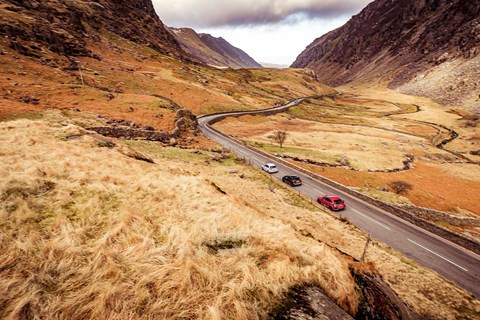► CAR’s hot hatch daily drivers
► Out and about in Snowdonia
► RS vs Type R vs N
Ben Pulman’s Ford Focus RS
There comes a moment – after five hours of motorway torture – when the Focus RS and I finally click. I’ve slogged up from London to escape the day-to-day grind where this fast Ford frustrates, to get away to North Wales, to the sort of roads on which we all originally fell for this car. Meeting me somewhere ahead are Curtis and the Civic Type R and James and his Hyundai i30N. And by the time I meet them in Snowdonia, my little epiphany has me wondering whether these two newcomers are also-rans to an ageing hot hatch that’s nearly out of production.
Read more on our Ford Focus RS long-term review
First on a shortcut I’ve never taken before, and then on old favourite B-roads, the Focus RS is just so damn fast. So quick I accidentally jump it. Twice. You stop thinking about the jarring ride, the Recaro seats mounted closer to the roof than the floor, and the diabolical range. Instead you engage Sport mode and relish the way the exhaust spits and pops, marvel at how agile and alert it feels. The Focus RS just grips and goes (whereas I’ll later discover the other two will spin their front wheels in the wet). And with all the power and torque, this Ford really does fly along even the wettest, roughest roads.

By the time I arrive in Betws-y-Coed covered in a thick layer of winter grime, the brakes are stinking and the tank is nearly empty but I’m thinking there might not be a finer hot hatch for that moment when you’re alone on your favourite road.
Which is what we’re doing here today. Hot hatches are built to cover all the bases, but for 24 hours we’re forgetting about them having to do the school run or trips to the shops. We’re escaping the straitjacket of the everyday; instead, it’s three mates, on an old stomping ground, having fun with their cars.
Let me point out the faults of the others before they have a chance to get stuck in to the Focus. The Type R channels the ’90s Impreza or Evo vibe, complete with embarrassing rear wing and bonnet intake. The rear wheels look lost inside the arches, as if design forgot to tell engineering to order some 5mm spacers. At speed there’s too much road noise, while the engine is inaudible. And initially all of the N elements feel tacked onto the i30: at parking speeds the clutch and steering are in ultra-light OAP mode, and it has an inordinately thick steering wheel – one of the less welcome things N division chief Albert Biermann brought with him from BMW’s M division. The wheel also has a woeful lack of adjustment.
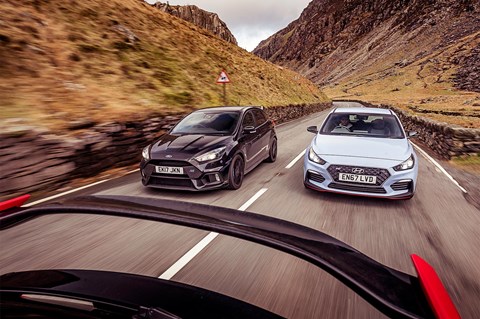
Move beyond the foibles, though, and both start to show some real brilliance – enough to trouble the Focus RS. The Type R has great seats and a superb gearbox, and the modulation through the brake pedal is fantastic. Nothing is quite so obviously standout on the i30N, and yet the overall package might even be better. The seats are good, the gearbox is good, the brakes are good, the engine makes the best noise here (at least inside the car), but overall it’s the togetherness, the way the i30N flows down a road that impresses me most.
By Ben Pulman
Logbook: Ford Focus RS
Engine 2261cc 16v turbo 4cyl, 345bhp @ 6000rpm, 347lb ft @ 2000rpm
Transmission Six-speed manual, all-wheel drive
Stats 4.7sec 0-62mph, 165mph, 175g/km CO2
Price £32,265
As tested £35,390
Miles this month 728
Total 6817
Our mpg 24.2
Official mpg 36.7
Fuel this month £181.21
Extra costs None
Curtis Moldrich’s Honda Civic Type R
You grow attached to a car when you drive it every day and use it for countless trips to Ikea while moving house. But as the sat-nav flashes up a four-hour journey time to Betws-y-Coed, I realise this is the strongest test of our relationship yet.
I know I’ve a whole day of far more spirited driving in prospect tomorrow, so the majority of today’s journey takes place in Comfort mode, with the car’s lane-keeping and adaptive-cruise toys on – and it’s relatively painless. For most of the four hours the Civic Type R and I happily bomb across England, podcast on, with only a mire of traffic near Birmingham interrupting things.
Read more on our Honda Civic Type R long-term review
Four hours gives you plenty of time to wonder why your colleagues are dragging you to Wales – but as I draw closer to the destination, the reason soon becomes obvious. As motorway gives way to B-road and then ever more intricate winding tarmac, it’s clear that this is exactly the sort of landscape the Type R was made for. But before that I need to stop for a curry, because I’ve been warned that the hotel we’re staying at won’t be serving food by the time I arrive.
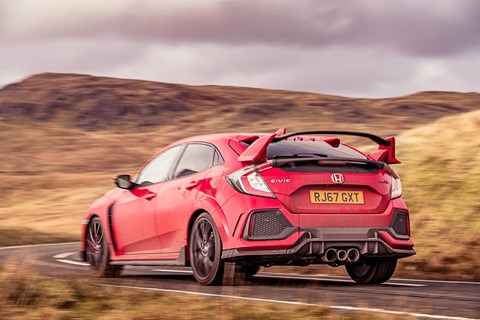
Main beams on, balti, garlic naan and rice in the footwell, podcast paused; it’s time for a quick shakedown. My three-mile drive from the takeaway to the hotel is more enjoyable than it should be, and would probably disqualify me from working for Deliveroo.
When the road ahead invites you to attack it, the Type R does so with such unfussed speed that it’s easy to forget just how fast you’re going – and just how composed it is. It’s only after I arrive and open my grease-covered takeway bag that I realise just how spirited the driving was. We find the garlic naan the next day.
When paired up against the i30N or the Focus RS, it becomes immediately obvious just how precise the Honda is. The Type R makes you feel like you’re cheating when you’re following the Ford or Hyundai, so clearly does it seem to have been made for these roads.
The Hyundai is one of the most enjoyable cars I’ve driven, and it’s one of the most silly too, but where it weaves and bobs along B-roads, the Type R surgically slices its way through them, with its subtle engine note and keen steering. The brakes are predictable and intuitive too, constantly goading you to brake later – and giving you ample feedback when you’re a little too ambitious.
Unlike the Hyundai there’s almost no torque steer here – it’s been successfully engineered out – and there are no electronically enhanced parps or warbles either. It’s just about going as fast as possible with the equipment provided.
As for the Focus RS, I never seem to gel with it in the same way I do the Hyundai or Honda. Whether it’s the odd driving position, or perhaps the heavier four-wheel drive, I’m not sure – but it just doesn’t seem to inspire the same level of confidence as the Type R. What’s more, its ride is firmer than the skateboard-like i30N’s, and around 10 minutes into my time with the Ford I’m relieved this isn’t the car I’ll be driving home. From the outside at least, it’s also rather plain, although some will prefer the subtle look. It’s clearly a technically impressive car, but of this trio it’s not the one I’d want to buy.
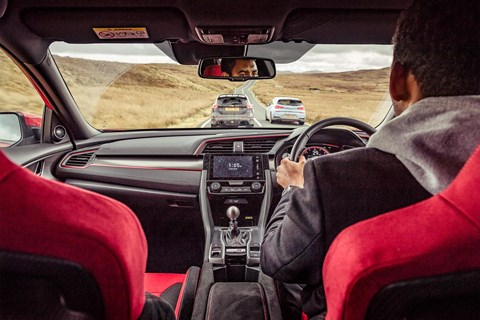
While the i30N is a cheeky, classic hot hatch, I’m leaning towards the Civic Type R. The Honda wears its character on its sleeve, with outrageous angles, edges and curves all over its widened shell. It’s supercar drama on a hot-hatch body, but somehow it also has scope to be comfortable – and still have enough room for a TV stand and Billy bookcase. It’s the car I’d part with my money for, because it just does everything.
By Curtis Moldrich
Logbook: Honda Civic Type R GT
Engine 1996cc 16v turbo 4cyl, 316bhp @ 6500rpm, 295lb ft @ 2500rpm
Transmission Six-speed manual, front-wheel drive
Stats 5.8sec 0-62mph, 169mph, 176g/km CO2
Price £32,995
As tested £32,995
Miles this month 2317
Total 4525
Our mpg 32.1
Official mpg 36.7
Fuel this month £431.19
Extra costs None
James Taylor’s Hyundai i30N
I turn up in the i30N expecting it have its tailgate handed to it by the two established stars. After all, it’s more than £4k cheaper, its power output starts with a 2 rather than a 3, and it’s the first proper go at this sort of thing from a company with no track record in driver’s cars. But it goes on to give both a black eye and very nearly win on points.
The i30 feels right at home in the Welsh hills, with tireless brakes, a neutral handling balance, and serious straight-line speed. Both Ford and Honda are fast enough to make your eyes go wide like a Warner Bros cartoon character, but it says a lot for the Hyundai that it doesn’t feel slow by comparison.
Read more on our Hyundai i30N long-term review
As Curtis says, the Type R could have been made for these roads. Well, it was made for the Nürburgring, but this bit of Wales is kind of the same thing. I loved it on its launch in Germany and fretted it might not feel as good back in the UK, but needn’t have worried. It feels spot-on from the moment you leave the car park, the steering pin-point precise, the gearchange even more so, and the brake pedal X-raying the road surface and transmitting the data straight to the sole of your shoe. Considering there’s 316bhp coursing through its front wheels there’s barely any torque-steer, thanks partly to a dual-axis front axle with a separate hub-carrier. The less expensive i30N doesn’t have that, and suffers from more torque-steer as a result, but it’s not unmanageable. Its steering is very heavy, perhaps to reinforce the idea of ‘sportiness’, and isn’t all that feelsome. Likewise its ride is overly firm, even in the adaptive dampers’ softest setting.
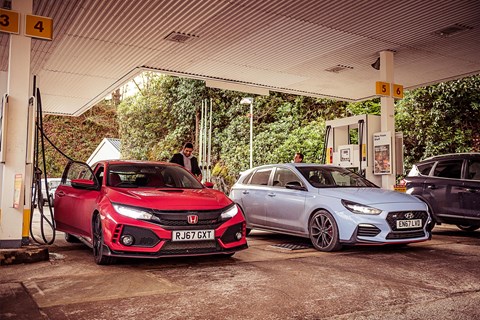
At least, I thought it was before I climbed into the Focus. I’d forgotten just how harsh it is, bumps making it pogo like a Sex Pistols front row circa 1977. I reach for the damper mode switch (positioned on the end of the indicator stalk) to soften them – before realising it’s already in its comfiest setting. And the turning circle! I thought the i30 was bad but at one point the Focus needed reverse to get around an empty car park. I have fond memories of great drives in the RS, but today its overservo’d brakes, overbolstered seats, overbuilt dashboard and comedy ergonomics all marr the experience.
Until, that is, we reach a favourite road, and I experience an epiphany similar to Ben’s. Having the rear axle in play gives its handling an extra dimension compared with the front-drivers. Here it’s impossible not to like the Focus. You get the impression its engineers are still giggling with glee at having got its incredible bitsa running gear past the accountants and into production. It’s a great drive, but I’m not sure I’d want to live with one all year round.
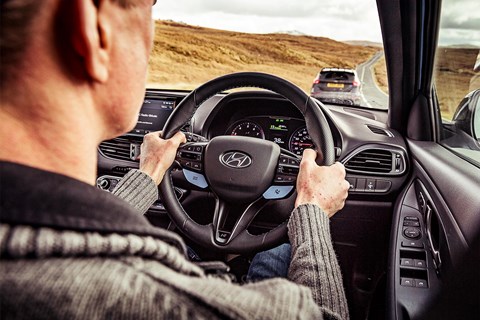
Despite its wild looks, the Civic is actually the most practical. It has the biggest boot, the best ride quality and the least droning exhaust on the motorway. Let’s gloss over its unfathomable touchscreen. It’s my favourite to drive, with the best damping, the best-weighted controls and incredible point-to-point pace. It’s more a go-where-you-point-it guided-missile experience than the i30, but some drivers might prefer the Hyundai’s more mobile rear axle, just as they might also prefer its vastly better ergonomics and less outré styling. In the right circumstances the Focus is the most fun, while the Civic is usually the best to drive – and as we head home from Wales I’m more convinced than ever that the i30N is the best to live with.
By James Taylor
Logbook: Hyundai i30N Performance
Engine 1998cc 16v turbo 4cyl, 271bhp @ 6000rpm, 260lb ft @ 1500rpm
Transmission Six-speed manual, front-wheel drive
Stats 6.1sec 0-62mph, 155mph (limited), 163g/km CO2
Price £27,995
As tested £28,550
Miles this month 1214
Total 2465
Our mpg 26.0
Official mpg 39.8
Fuel this month £266.06
Extra costs None
Check out our CAR comparison tests here
